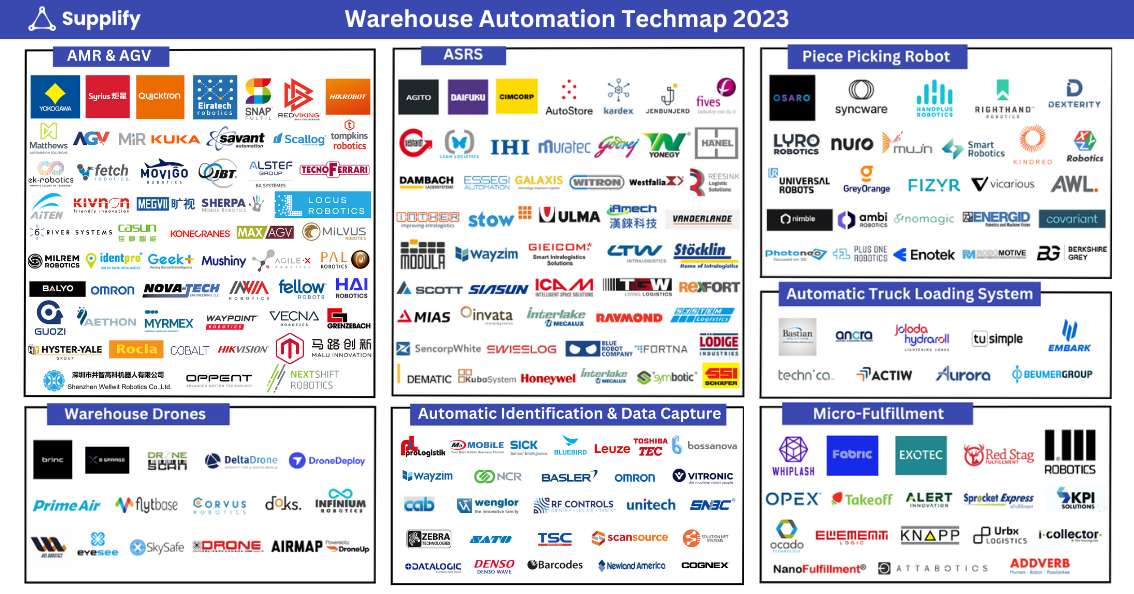
In a fast-paced world where technological advancement is reshaping industries, warehouse technology has emerged as a crucial element in the logistics and supply chain landscape. From robots that automate picking processes to systems that offer real-time data analysis, the integration of various technologies is revolutionizing the way warehouses function.
We at Alcott Global, have been working hard on growing our Supplify platform. There are over 1000+ solution providers focused on supply chain technologies. This map covers just a few of them. More details and categories are on the Supplify platform. If you need tech help with your supply chain operations, let us know!
In this article, we’ll explore the myriad of technologies that are transforming the warehousing sector, including Autonomous Mobile Robots (AMRs), Automated Guided Vehicles (AGVs), Automated Storage and Retrieval Systems (ASRS), and much more. We will delve into how these groundbreaking innovations enhance efficiency, reduce costs, and align with broader environmental goals. Join us as we unveil the importance and effectiveness of warehouse technology in building a responsive, agile, and sustainable supply chain and uncover the investment trends that signify future steering towards a technologically advanced and data-driven industry.
AMRs (Autonomous Mobile Robots) and AGVs (Automated Guided Vehicles)
AMRs and AGVs are groundbreaking technologies revolutionizing the warehousing and supply chain management sectors. AMRs navigate autonomously using sensors, cameras, and algorithms, adapting to changes within their environment, while AGVs follow predetermined paths guided by wires, lasers, or magnets, providing efficient and reliable transportation within structured environments. Both technologies enhance warehouse efficiency by automating the transportation of goods and materials, reducing manual handling and travel times, and increasing accuracy. This leads to faster order fulfillment and timely deliveries and contributes to the overall effectiveness of the supply chain.
These innovations further transform supply chain operations by offering scalability, flexibility, labor cost reduction, improved safety, real-time tracking, and sustainability. AMRs are particularly versatile, able to navigate complex spaces and scale according to demand, while AGVs can be expanded through additional vehicles. By automating material handling, they significantly lower labor costs and enhance safety, with the integration into Warehouse Management Systems (WMS) enabling real-time decision-making support. Energy optimization in both AMRs and AGVs also promotes a more sustainable supply chain, aligning with broader environmental goals.
Automated Storage and Retrieval Systems (ASRS)
ASRS systems are revolutionizing warehousing by offering improved space utilization, efficiency, and scalability. Designed to maximize available space through vertical storage solutions and minimizing aisle width, ASRS dramatically increases storage density, thereby lowering warehouse costs and boosting the overall supply chain efficiency. They allow for faster and more precise picking and storage processes through automation, utilizing algorithms and real-time data to enhance productivity. Furthermore, ASRS can be easily scaled to adapt to changing business needs, ensuring that the warehouse remains agile and resilient to demand fluctuations.
ASRS also provides enhanced inventory control and labor savings. With real-time tracking and data analytics, these systems offer full visibility into inventory levels, leading to better control and reduced carrying costs. This ensures that businesses can meet customer expectations while minimizing excess or out-of-stock situations. The automation of storage and retrieval processes diminishes the need for manual labor, cutting costs and allowing the workforce to focus on value-added tasks. This not only leads to further savings but also reduces the risk of workplace injuries.
Piece Picking Robots
Piece Picking Robots are advanced robotic systems specifically designed to pick individual items from various locations, such as shelves, bins, or conveyor belts. Utilizing cutting-edge technology such as artificial intelligence (AI), machine learning algorithms, and advanced vision systems, they are capable of recognizing and handling a wide array of products with remarkable precision. These robots significantly enhance the efficiency and accuracy of the picking process, working tirelessly to reduce processing time and minimize errors. Additionally, they are highly flexible and adaptable, capable of handling diverse merchandise ranging from small electronics to bulky packages, and can be easily scaled to meet changing demands.
These specialized robots offer a wide range of benefits within the supply chain, from cost reduction to improved working conditions. By automating labor-intensive tasks, Piece Picking Robots decrease reliance on manual labor, leading to substantial savings in wages and other expenses. Their precision minimizes costly mistakes and returns, and by taking over repetitive tasks, they improve the workplace environment, reducing the risk of injuries and allowing human workers to focus on more complex and engaging activities. Integration with other warehouse technologies like Warehouse Management Systems (WMS) and Automated Storage and Retrieval Systems (ASRS) ensures a cohesive, streamlined supply chain.
Automated Truck Loading Systems (ATLS)
ATLS represents a significant advancement in logistics, designed to handle the loading and unloading of trucks without human intervention. Utilizing a combination of technologies such as conveyors, robotic arms, and AGVs (Automated Guided Vehicles), ATLS enables the seamless transfer of goods to and from trucks. The implementation of these systems greatly enhances the efficiency and speed of the loading process, allowing for quicker turnaround times and more deliveries. With computerized control and monitoring, they ensure accuracy and precision, drastically reducing the chances of errors or damages, and their flexibility allows them to handle various types and sizes of goods, adapting effortlessly to different products and delivery requirements.
ATLS provides multiple benefits to the supply chain beyond just speed and accuracy. By automating the loading and unloading process, they substantially cut labor costs and associated expenses. They can operate around the clock without fatigue, minimizing the need for multiple shifts and reducing product damage for further cost savings. The reduction in manual labor also enhances safety, lowering the risks and potential costs related to workplace injuries. These systems also contribute to sustainability by optimizing loading, reducing energy consumption, and ensuring that trucks are loaded to maximum capacity, thereby minimizing transportation needs and emissions.
Warehouse Drones
Warehouse drones, equipped with cameras, sensors, and sometimes robotic arms, are becoming essential tools in modern warehouse operations. These drones can be controlled remotely or programmed to fly autonomously and offer a plethora of benefits to the supply chain. From real-time inventory management through regular scans of barcodes or RFID tags to improved picking efficiency by quickly locating specific items, drones streamline processes. They also enhance security by monitoring for unauthorized access or potential hazards, provide safe inspections of hard-to-reach areas, and contribute to sustainability by consuming less energy. Their scalability allows them to adapt to varying demands, and their integration with other technologies like Warehouse Management Systems (WMS) and Automated Guided Vehicles (AGVs) ensures coordinated and efficient operations.
The data collected by warehouse drones also leads to data-driven insights that can be leveraged to optimize storage layouts, improve workforce allocation, and uncover inefficiencies. This continuous monitoring and information gathering contributes to more effective and streamlined supply chain management. Whether it’s enhancing safety by reducing the need for workers to access risky spots or providing energy savings through quicker navigation, the efficiency, and adaptability of drones make them valuable assets.
Automatic Identification and Data Capture (AIDC)
AIDC involves various technologies like barcoding, RFID, QR codes, and biometrics that capture, identify, and analyze data within the supply chain. These technologies offer an array of benefits, including enhanced visibility and transparency, by providing real-time insights into every stage of the supply chain, allowing for quick adjustments. AIDC improves accuracy by automating data capture, streamlines inventory management through precise tracking, and accelerates order processing, thus reducing lead times and enhancing customer satisfaction. Additionally, AIDC ensures compliance with regulations, facilitates quality control, enables data-driven decision-making, and can be seamlessly integrated with other systems like Warehouse Management Systems (WMS) for cohesive operations.
AIDC’s efficiency also leads to significant cost reduction by minimizing labor costs and errors. This cost-saving strategy helps businesses reinvest in other areas or offer benefits to customers. Whether through RFID tags for detailed tracking or barcode scanners for quicker order processing, AIDC technologies reshape how supply chains function, driving continuous improvement and agility in business operations.
Micro-Fulfillment
Micro-fulfillment is an innovative strategy in supply chain management that focuses on using compact and technologically advanced warehouses, known as micro-fulfillment centers (MFCs), situated close to urban areas. These centers allow for quicker fulfillment of online orders through the use of robotics and automation. The key benefits of micro-fulfillment include faster delivery times, reduced shipping costs due to minimized travel distances, improved inventory management tailored to local demand, and enhanced customer experience through options like same-day delivery and buy-online-pick-up-in-store (BOPIS). Additionally, this strategy supports sustainability by reducing fuel consumption and offers flexibility, scalability, and integration with modern technologies like AI and data analytics, aligning with both omnichannel strategies and environmental consciousness.
The implementation of micro-fulfillment creates a localized and agile approach to supply chain management, meeting the growing demands for immediacy and convenience in the e-commerce landscape. It represents a significant shift towards customer-centric operations, encompassing principles of engagement, sustainability, and innovation. Through its intelligent use of technology and responsiveness to market dynamics, micro-fulfillment is shaping the future of retail and supply chain management, providing a competitive edge for businesses.
Current Investment Trends in Supply Chain Technologies
The 2022 Warehouse & Distribution Center Equipment Survey paints a vivid picture of the current landscape of warehouse technology investments. The economy’s strong performance and the growth of e-commerce are driving companies toward more automation.
Budgets for material handling systems and related technology for 2022 came in at an average of $459,316, well above last year’s average anticipated spend of $306,990. This surge in spending shows that companies are progressively embracing technology to enhance productivity.
Investments in specific areas like lift trucks, conveyors, sortation, robotics, and automation have seen substantial growth. Warehouse technologies such as AMRs, AGVs, ASRS, piece-picking robots, automatic truck loading systems, drones, AIDC, and micro-fulfillment are leading this evolution.
Furthermore, the survey reveals an increase in spending on training, highlighting the need for a skilled labor force to interact with new technological implementations. While there’s a shift towards automation, spending on labor has also seen an uptick, indicating a balanced approach.
Warehouse technology represents a significant cut of overall investments in the supply chain. For instance, AMRs and AGVs marked a 3% growth versus last year, and the investment in systems equipment, including automated retrieval, jumped from 24% to 44%.
These trends signify that warehouse technology is not merely a replacement for human labor but a strategic investment aimed at enhancing productivity, efficiency, and growth in an increasingly competitive market. The future of warehousing seems to be steering towards a technologically advanced, data-driven, and responsive industry, continuously adapting to meet the demands of a global economy.




